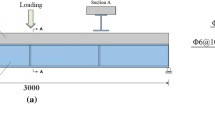Abstract
Over the past few years, composite steel–concrete beams saw numerous applications in bridge construction because of their competitive cost in comparison with non-composite steel or reinforced concrete structures. Bridges, in particular and industrial structures in general, are commonly subjected to cyclic loading of vehicles or operating machines. This made it important to study and investigate the behavior of composite structures under fatigue. In this study, the cyclic loading behavior of simply supported composite beams was analyzed numerically using ANSYS finite element software. Following analysis validation using the experimental literature load–deformation results, the numerical models were used in a parametric study to investigate the response under cyclic loading to varying degree of shear connection between the beam’s concrete slab and steel section. According to finite element simulation results, there was consistent compatibility in terms of stiffness changes with fatigue life, low deflection values, increased fatigue life and a clear delay in reaching the failure under achieving more than 80% of composite action in order to have the optimum performance under fatigue loading. Shear lag phenomenon—which is a good indication of the continuity in strain between concrete slab and steel beam—was also observed, and it had an influence effect on studying the weld region between shear connectors’ body as a target element and top flange of the steel beam in order to achieve the required degree of composite action.



































Similar content being viewed by others
Abbreviations
- F.E.M.:
-
Finite element modeling
- “S–N” method:
-
Relationship between the shear stress range and fatigue life of shear connectors
- Δτ :
-
Shear stress amplitude (MPa)
- Δ:
-
Deflection of composite beam (mm)
- N :
-
Number of cycles (× 104)
- δ :
-
Slippage of concrete slab on steel top flange (mm)
- η :
-
Number of cycles at first shear stud failure (× 104)
References
Slutter, R.G.; Fisher, J.W.: Fatigue strength of shear connectors. In: 45th annual meeting of the Highway Research Board, vol. 315, no. 147 (1966)
Siess, C.P.; Viest, I.M.; Newmark, N.M.: Studies of slab and beam highway bridges. Part III, small-scale tests of shear connectors and composite Tbeams. Bulletin 396, University of Illinios, Urbana, Illinios (1952)
Ollgaard, J.G.; Slutter, R.G.; Fisher, J.W.: Shear strength of stud connectors in lightweight and normal weight concrete. Eng. J. Am. Inst. Steel Constr. April 1971 (71-10) (1971)
Hirokazu, F.Y.; Shigeyuki, M.: Static and fatigue strength of studs. In: Iabse Symposium, 199AD, pp. 197–202
Gattesco, N.; Giuriani, E.: Experimental study on stud shear connectors subjected to cyclic loading. J. Constr. Steel Res. (1996). https://doi.org/10.1016/0143-974X(96)00007-7
Yen, J.Y.R.; Lin, Y.; Lai, M.T.: Composite beams subjected to static and fatigue loads. J. Struct. Eng. (1997). https://doi.org/10.1061/(ASCE)0733-9445(1997)123:6(765)
Johnson, R.P.: Resistance of stud shear connectors to fatigue. J. Constr. Steel Res. (2000). https://doi.org/10.1016/S0143-974X(99)00082-6
CEN: Eurocode 4: design of composite steel and concrete structures—part 1.1: general rules and rules for buildings. Eur. Comm. Stand. (2004)
Taplin, G.; Grundy, P.: Steel-concrete composite beams under repeated load. In: Proceedings of the Conference: Composite Construction in Steel and Concrete IV, pp. 37–50 (2000). https://doi.org/10.1061/40616(281)4
Hanswille, G.; Porsch, M.; Ustundag, C.: Resistance of headed studs subjected to fatigue loading. J. Constr. Steel Res. (2007). https://doi.org/10.1016/j.jcsr.2006.06.035
Dawood, M.; Rizkalla, S.; Sumner, E.: Fatigue and overloading behavior of steel–concrete composite flexural members strengthened with high modulus CFRP materials. J. Compos. Constr. (2007). https://doi.org/10.1061/(ASCE)1090-0268(2007)11:6(659)
Yu-Hang, W.; Jian-Guo, N.; Jian-Jun, L.: Study on fatigue property of steel–concrete composite beams and studs. J. Constr. Steel Res. (2014). https://doi.org/10.1016/j.jcsr.2013.11.004
Xu, C.; Sugiura, K.: FEM analysis on failure development of group studs shear connector under effects of concrete strength and stud dimension. Eng. Fail. Anal. 35, 343–354 (2013). https://doi.org/10.1016/j.engfailanal.2013.02.023
El-Zohairy, A.; Salim, H.: Behavior of steel–concrete composite beams under fatigue loads. In: Conference Proceedings of the Society for Experimental Mechanics Series, vol. 7 (2018). https://doi.org/10.1007/978-3-319-62831-8_14
Higashiyama, H.; Yoshida, K.; Inamoto, K.; Matsui, S.; Kaido, H.: Fatigue of headed studs welded with improved ferrules under rotating shear force. JCSR 92, 211–218 (2014). https://doi.org/10.1016/j.jcsr.2013.09.012
Ovuoba, B.; Prinz, G.S.: Fatigue capacity of headed shear studs in composite bridge girders. J. Bridge Eng. (2016). https://doi.org/10.1061/(ASCE)BE.1943-5592.0000915
Xu, C.; Su, Q.; Sugiura, K.: Mechanism study on the low cycle fatigue behavior of group studs shear connectors in steel–concrete composite bridges. J. Constr. Steel Res. 138, 196–207 (2017). https://doi.org/10.1016/j.jcsr.2017.07.006
Desayi, P.; Sundara Raja Iyengar, K.T.; Sanjeeva Reddy, T.: Equation for stress-strain curve of concrete confined in circular steel spiral. Matériaux Constr. (1978). https://doi.org/10.1007/bf02473875
Gere, J. M.; Timoshenko, S.P: Mechanics of Materials. PWS Publishing Company, Boston, Massachusetts (1991). https://doi.org/10.1007/978-1-4899-3124-5
AASHTO: AASHTO LRFD bridge. ProQuest Dissertations and Theses, p. 1661 (2012)
AASHTO: Guide Manual for Bridge Element Inspection. Bridge Element Inspection Guide Manual (2011)
AASHTO: AASHTO Bridge Element Inspection Guide Manual. Bridge Element Inspection Guide Manual (2011)
Johnson, R.P.: Loss of interaction in short-span composite beams and plates. J. Constr. Steel Res. 1(2), 11–16 (1981). https://doi.org/10.1016/0143-974X(81)90028-6
Ovuoba, B.; Prinz, G.S.: Investigation of residual fatigue life in shear studs of existing composite bridge girders following decades of traffic loading. Eng. Struct. (2018). https://doi.org/10.1016/j.engstruct.2018.02.018
Lam, D.; El-Lobody, E.: Behavior of headed stud shear connectors in composite beam. J. Struct. Eng. (2005). https://doi.org/10.1061/(ASCE)0733-9445(2005)131:1(96)
Navr, J.: Eurocode Design Of Composite Concrete, no. 1, pp. 1–6 (2014)
Badie, S.S.; Morgan Girgis, A.F.; Tadros, M.K.; Nguyen, N.T.: Relaxing the stud spacing limit for full-depth precast concrete deck panels supported on steel girders (phase I). J. Bridge Eng. (2010). https://doi.org/10.1061/(asce)be.1943-5592.0000082
Hamilton, R.; Tennyson, S.; Hamilton, W.: Analysis by the transformed-section method. In: ASEE Annual Conference Proceedings (2001)
Author information
Authors and Affiliations
Corresponding author
Ethics declarations
Conflict of interest
The authors declare that they have no conflict of interest.
Rights and permissions
About this article
Cite this article
Hassanin, A.I., Shabaan, H.F. & Elsheikh, A.I. The Effects of Shear Stud Distribution on the Fatigue Behavior of Steel–Concrete Composite Beams. Arab J Sci Eng 45, 8403–8426 (2020). https://doi.org/10.1007/s13369-020-04702-4
Received:
Accepted:
Published:
Issue Date:
DOI: https://doi.org/10.1007/s13369-020-04702-4




